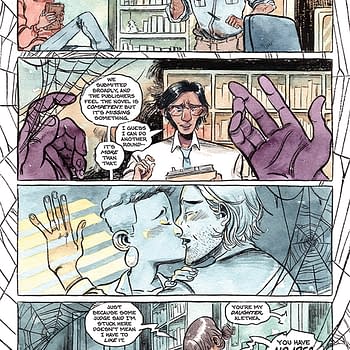Posted in: Comics, Recent Updates | Tagged: Alan Moore, avatar press, Comics, entertainment, jacen burrows, providence
I Have Read Alan Moore And Jacen Burrows' Providence #1 And It's Eerily Inclusive
I doubt Alan Moore has had much dealing at all with video games (though that may be increasing due to the digital aspects of the Electricomics project) or interest in them but, yes, it's particularly strange that one of the things that occurs to me when approaching the first issue of his new comic Providence, with artist Jacen Burrows, is a concept of "agency" most often discussed in the context of gaming. But it's also discussed in terms of whether characters are well-rounded, feel and seem like they have their own personalities and psychology, or have been treated as simply wooden objects to help frame a story or plot. For instance, one might discuss whether female characters in a male-character dominated comic have enough agency. Can they do things? Do they seem to act autonomously of those around them and have a permanent effect through their actions?

I can think of several reasons why Providence gives this impression to the reader and several reasons why this is a really important development for comics. The effect of all this on you, the reader, however, will be both eerie and exhilarating and may well give you a feeling of stepping outside the medium of comics that you feel you know so well. Or perhaps further inside? That's probably up for interpretation.

As a teaser, rather than a spoiler, I'll quote a hand-written letter that appears at the beginning of the first issue of Providence. It uses the phrase "break through mere words to the reality lying beyond them", and the phrase is visually emphasized by actions on that page. What Providence the comic seems to do is take Lovecraft's work as the "words" and "break through" them to a "reality lying beyond them". In what sense is this work Lovecraft? In the sense that Lovecraft's stories have been woven together into a single tapestry at carefully chosen points of intersection. For those who know Lovecraft's work well, they will be tripping over hints and clues at every turn in peoples' names, in comments from characters, in settings, and situations. In the first Issue of the comic alone, which in any story needs to be used for set up of the plot, we nevertheless have several Lovecraftian references, an entire story alluded to and pre-quelled, and the beginnings of an even bigger adventure into menacing territory.

I mentioned agency—which works in the comic because we feel we are Robert and that we are making his choices as he moves cleanly around in his world, a world so enhanced in its realism that it does feel like exploring the vast digital worlds created on massive platform games (and this is only the first issue of the comic even)— but I also said this comic is like a sandbox game. What I mean by that specifically is that the reader helps construct the world of this comic. That may seem unlikely given the radical level of historical detail that Moore and Burrows have employed (as Burrows discussed in an interview here) to the degree that every surface seems like it "really" exists (and many of those surfaces still do, especially in New York City), but what the reader constructs is the web of allusion and interacting references that tie us to Lovecraft's own world and his created world.

Moore and Burrows have put the monsters back in Lovecraft. "Real" monsters the way monsters you've never seen before affect you as "real" monsters. Issue #1 is all about showing us the surface of things and beginning to suggest the depth of the darkness that lies beneath it, and watching Robert Black, aka the reader, purposefully start to pull back the surface of things. And there's no telling what he'll find, but it will be very Lovecraftian indeed. The inclusivity of this comic makes almost anything possible when it comes to feats of the imagination because it's powered and co-created by you.
Providence #1 arrives on May 27th, and the order period for the first issue is rapidly coming to a close so don't miss out!















